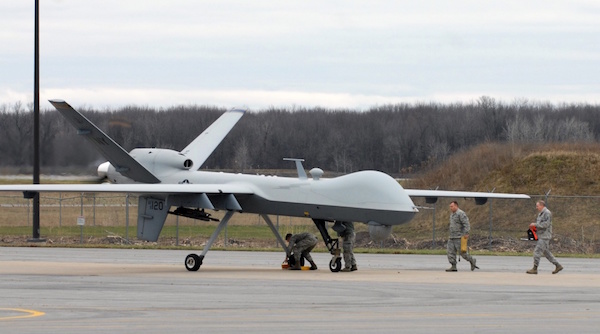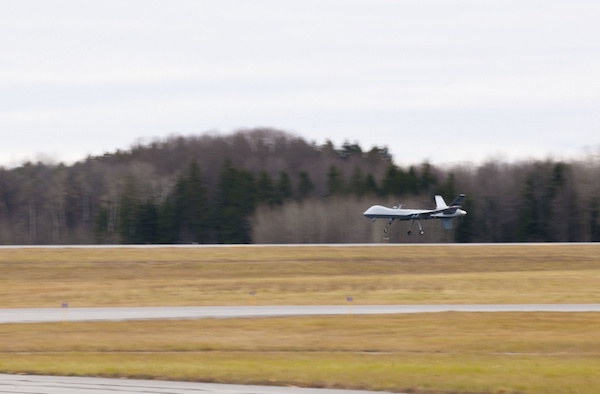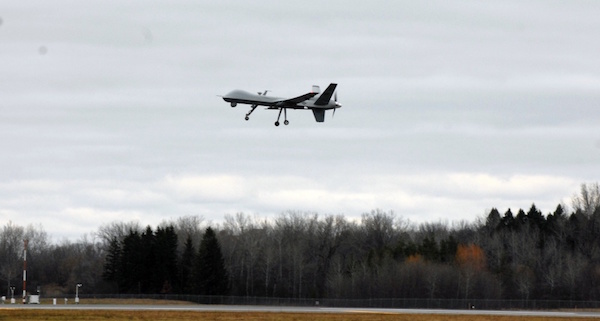
Oct. 7, 2016 // Syracuse ATCT and TRACON Safely Integrates UAS

From the moment an MQ-9 Reaper remotely piloted aircraft launched into their airspace nearly one year ago in a demonstration flight, NATCA members at Syracuse Tower and TRACON (SYR) knew they were soon going to be part of an important new chapter in aviation history.
After four months of successful testing, the SYR operation that now includes the safe integration of both civilian aircraft and remotely piloted aircraft from the New York Air National Guard’s 174th Attack Wing is a source of pride for all involved. SYR is the first Federal Aviation Administration (FAA)-controlled civilian airport to handle both manned and unmanned traffic.
“They were all very excited when the Air Force came to the tower to introduce this program,” SYR FacRep Andy Flynn said of his local’s members. “When they told us how the remotely piloted aircraft would be used, we all said, ‘alright, we’ll see.’ But then, lo and behold, in June, there they were in our pattern. We are a moderately-sized airport and we don’t get the normal touch-and-go’s. So this is a shot in the arm for us.”
 In recent years, Flynn said, general aviation (GA) traffic has been down, meaning fewer pattern traffic operations for controllers to work. However, he said GA is now back on the rise as fuel prices have fallen. The same is true for all of central New York, he said. Thus, the MQ-9 is a welcome addition to the SYR traffic count, as well as a key pilot program for a part of the future of the National Airspace System (NAS).
In recent years, Flynn said, general aviation (GA) traffic has been down, meaning fewer pattern traffic operations for controllers to work. However, he said GA is now back on the rise as fuel prices have fallen. The same is true for all of central New York, he said. Thus, the MQ-9 is a welcome addition to the SYR traffic count, as well as a key pilot program for a part of the future of the National Airspace System (NAS).
“They are trailblazing for the FAA on processes and procedures for how this can work safely because there are going to be others that follow,” NATCA Unmanned Aircraft Systems (UAS) Representative Steve Weidner said, adding that Fargo is on tap to be the next facility, perhaps in mid-to-late 2017. After that, there are more than a dozen other Guard units set to make this same transition to working with FAA facilities. “It’s a big deal,” he added.
Until SYR, the Air Force had operated its UAS only from military airfields. The 174th flew MQ-9s used to train pilots and sensor operators — those responsible for manipulating the cameras and other instruments carried on board the UAS — from Wheeler Sack Army Airfield at Fort Drum, N.Y. The location created a logistical issue for the 174th, which had to expend time, effort, and resources to make the three-hour round trip to Syracuse. The New York Air National Guard says launching a UAS directly from SYR means more training time and cost savings.
National Guard officials said this year the 174th has been tasked to train 106 MQ-9 pilots and sensor operators, a 50 percent increase from 2015.
For controllers, working UAS is notably different in several ways. There is one pilot per aircraft and they work on the ground at SYR in a control station that looks somewhat like a flight simulator, complete with a stick and rudders. The aircraft have to stay within five miles while in the SYR pattern but can depart the Class C airspace if flying on to restricted military airspace. Each UAS has both a visual observer on the ground in an Air Force vehicle to ensure they are always within sight, and a “chase” aircraft — a Civil Air Patrol Cessna — that flies a mile behind the UAS to ensure it proceeds safely and follows all FAA regulations in its trip to military airspace.

“They come out for two hours at a time,” Flynn explains. “The way they are sequenced, they cannot maintain visual separation so we have to apply wake turbulence separation for them.”
“We are a little bit restricted,” he said. “It’s not like a normal plane where a VFR aircraft can take an instruction to follow a certain aircraft and maintain visual. We have to bring them (the UAS) further on the downwind and then bring them in.”
Weidner said the Reaper acts “very much like a manned aircraft. The only thing they can’t do is take a visual clearance, and the pilots aren’t legally allowed to use their display (from the on-board camera) for any type of visual maneuver.”
Flynn said the good of the program has far outweighed any challenges thus far. “It’s helping with our training to get local controllers to work consistent pattern traffic,” he said.
Even commercial pilots like sharing the airport with the UAS, Flynn added. The large Reapers are quite an aviation spectacle, especially up close.
“They get a kick out of it,” he said. “They taxi right behind them. We sometimes have to point it out to an unsuspecting pilot, about what’s going on.”
As for the UAS pilots, Flynn complimented them on their extremely high skill level.
“These guys are high-hour military pilots,” he said. “They’ve flown aircraft like the F-16 and the B-1 bomber. They know what they’re doing.”

